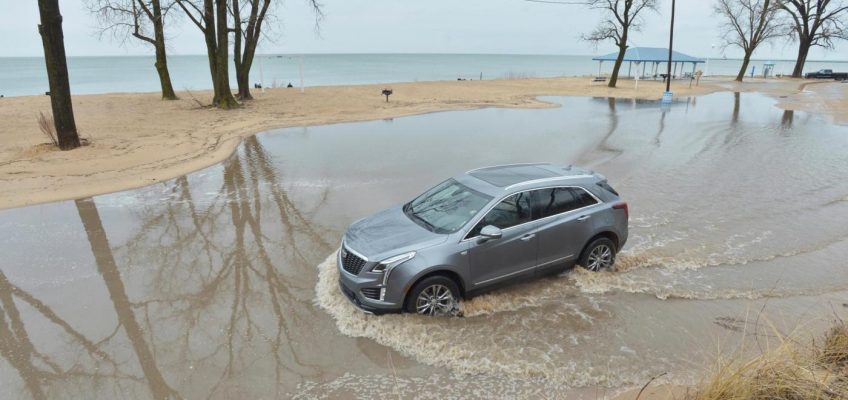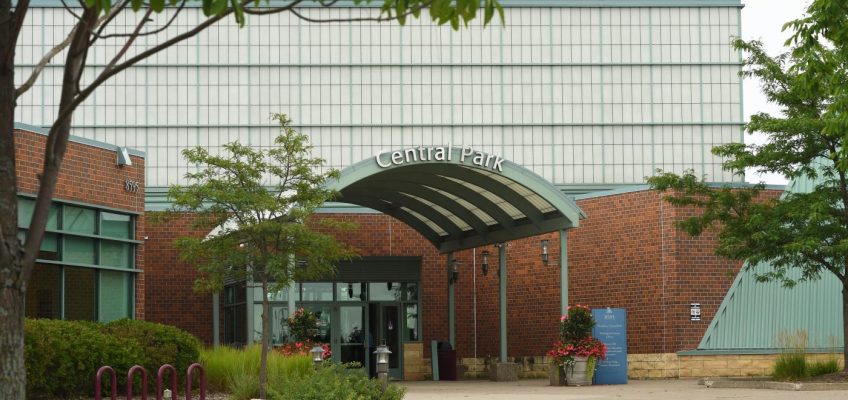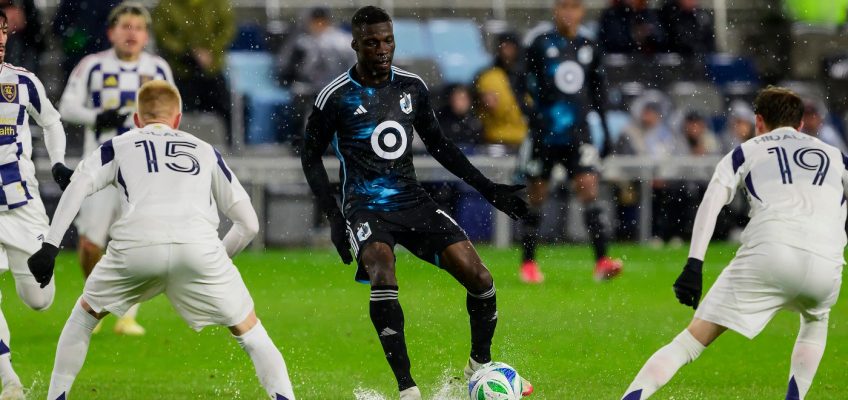Kelvin Yeboah’s first thought included skepticism.
The Italian/Ghanian striker joined Minnesota United last summer and was plugged in as the lone man atop the Loons’ attack. His first foray into MLS started off swimmingly with seven goals in 709 regular-season minutes.
But this season, head coach Eric Ramsay and the coaching staff wanted MNUFC to switch to a two-striker formation: with Yeboah playing alongside Canadian forward Tani Oluwaseyi.
“In the beginning, for sure, you are thinking, ‘Why change?’ ” Yeboah told the Pioneer Press this week. “And it’s a bit difficult to adapt to new changes, but eventually it all worked. We trusted (Ramsay) from Day 1, and we keep trusting him until now. So I think he’s doing really a good job.”
The switch has worked out for all parties. While opposing center backs have two strikers to worry about and account for on the field, Yeboah and Oluwaseyi have scored four goals each to tie for the fourth-most tallies in MLS through six games. Their production has boosted MNUFC (3-1-2) into fourth place in the Western Conference going into Sunday’s game against New York City FC (2-2-2) at Yankee Stadium.
“I feel like those two, if they needed convincing of the argument of playing as a pair, there’s enough evidence over six games to suggest that we can do really, really well,” Ramsay said.
Minnesota United forward Kelvin Yeboah (9) head the ball over Real Salt Lake midfielder Emeka Eneli (14) in the first half of a MLS game at Allianz Field in St. Paul on Saturday, March. 29, 2025. (John Autey / Pioneer Press)
Stumbles before big stage
Ramsay and Yeboah are quite alright over MNUFC’s strike partners not getting much praise for their early-season goal scoring successes.
“We’re quite happy with that, by the way; I think that suits us to an extent,” Ramsay said. “But also feel like that’s self inflicted, because if we had won one of the two games that we most definitely should have done against Kansas (City) and (L.A.) Galaxy, we would be, obviously, in a more eye-catching position.”
After losing leads in both those matches, MNUFC beat Real Salt Lake behind two goals from Oluwaseyi. The Loons will now go to New York, followed by Toronto next Saturday.
“Don’t really care,” Yeboah said about the lack of attention. “But yes, I do think we are a surprise for MLS. I think we are still considered a surprise, Minnesota United, in itself. The results speak for themselves, you know. So we are really keeping our head down and just keep working.”
Still a work in progress
Ramsay said the team reviewed the two-striker set-up before Thursday’s training session as it seeks more areas for improvement.
“The biggest message, both in and out of possession, for those (two) is that they stay close enough to one another,” Ramsay said. “And I think in order to get the benefit of one another’s movement and the benefit of each other’s physicality, they need to be close. And I think largely we’ve seen that over the course of most games. There are certain points in certain games where we start to drift a little bit from from one another.”
During small-sided drills and scrimmage situations in training sessions, the Loons’ starters are often broken up into different teams to find a competitive balance between the groups. On Thursday, Yeboah and Oluwaseyi remained together to further deepen their chemistry.
Oluwaseyi had back-to-back scoring chances early against RSL last Saturday, but didn’t convert. In the past, he said he would have dwelled on those missed opportunities, and people in his circle would have been reminding him to let it go.
“I’m just trying to … shout out to Ted Lasso, ‘Just be a goldfish,’ ” Oluwaseyi said about how the Apple TV show instilled the need for soccer players to have a short memory. “Just keep things in perspective and just forget everything that happens in the past and just keep going.”
Split scoring
All four of Oluwaseyi’s goals have come in open play or on counter-attacks, while three of Yeboah’s goals have derived from set plays and one on a penalty kick.
“There is an element on set plays (where) Kelvin, within the set-up, is in a better position to score than Tani,” Ramsay explained. “Tani is more likely to assist in those situations. I’d say there’s something in that.”
Oluwasseyi assisted on Yeboah’s (and the Loons’) first goal of the season, a tap-in off a corner kick in the 1-0 win over Montreal on March 1.
“I would also say in open play, Kelvin’s had some some good chances,” Ramsay said. “He’s yet to, sort of, set the world on fire when it comes to really eye-catching goals in the way that he did last year. But I think almost more pleasing for me and the staff is that he’s probably learned the value of a messy goal on a set play.”
Yeboah is looking to hone in on his natural instinct over where the ball is going to end up in sequences. When Galaxy goalkeeper John McCarthy failed to grab an attempt two weeks ago, Yeboah was there to poke it into the back of the net.
“You can never know,” Yeboah said. “So it’s always a bit of a gamble. But I’ve been gambling well in that sense.”
Competition?
Putting two ultra-competitive strikers on the field together might have led to them contrasting or combusting. But that hasn’t been the case.
Oluwaseyi said he made a joke about competing against Yeboah in practice, and Yeboah replied: “Don’t compete against me, compete against yourself.”
How Zen of Yeboah.
“As strikers, you have the edge always to compare because of numbers, because of whatsoever,” Yeboah said. “… Results are dictated by so many factors. So if you compete with yourself, you have a better chance to improve.”
Yeboah brought up how both players have different attributes. One example: Yeboah’s four goals have come with his preferred right foot, while Oluwaseyi has scored three with his favored left foot, and one with his head.
Just off the pace
Yeboah and Oluwaseyi’s goal totals are both within the Top 5 in MLS through six matches this season.
Top MLS goal-scorers in 2025:
1. Tai Baribo, Philadelphia, 6
2t. Hugo Cuypers, Chicago, 5
Emmanuel Latte Lath, Atlanta, 5
4t. Yeboah, 4
Oluwaseyi, 4
Christian Benteke, D.C., 4
Diego Rossi, Columbus, 4
Antony, Portland, 4
Evander, Cincinnati, 4
Alonso Martinez, New York City, 4
Martin Ojeda, Orlando City, 4
Marco Pasalic, Orlando City, 4
(Note: Only MNUFC and Orlando City have two players on the list, while Sunday’s opponent is represented with one.)
Little company
The Loons have had only one of the club’s annual leading scorers rank in the MLS Top 10 that season — and it came in the pandemic-shortened season in 2020:
Top MNUFC goal-scorers since 2017, with MLS rank:
2025 — T-4: Tani Oluwaseyi/Kelvin Yeboah, 4 goals
2024 — T-27: Bongi Hlongwane, 11 goals
2023 — T-21: Teemu Pukki, 10 goals
2022 — T-22: Emanuel Reynoso, 10 goals
2021 — T-27: Robin Lod, 9 goals
2020* — T-8: Kevin Molino, 9 goals
2019 — T-27: Darwin Quintero, 10 goals
2018 — T-22: Quintero, 11 goals
2017 — T-11: Christian Ramirez, 14 goals
Loons’ Dayne St. Clair relives playoff shootouts vs. Salt Lake
Loons let off, giving up three-goal lead in draw at Kansas City
Minnesota United’s Hassani Dotson breaks silence on trade request
Minnesota United at San Jose: Keys to the match, projected starting XI and a prediction
Canadian players on Loons feel ‘disrespect’ in President Trump’s ’51st state’ comments




